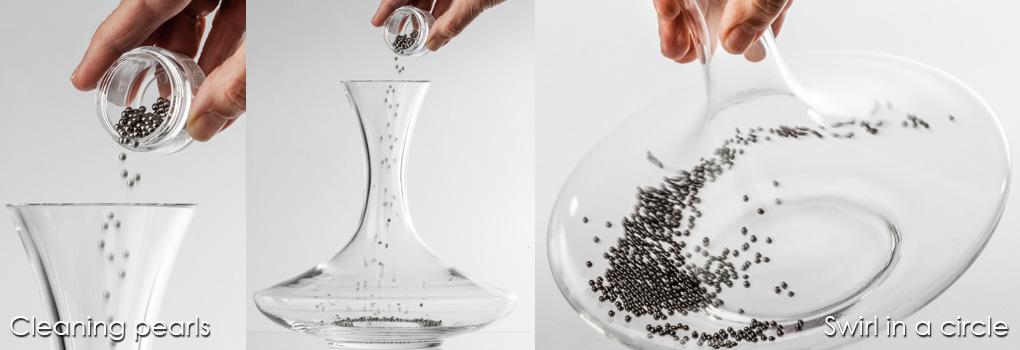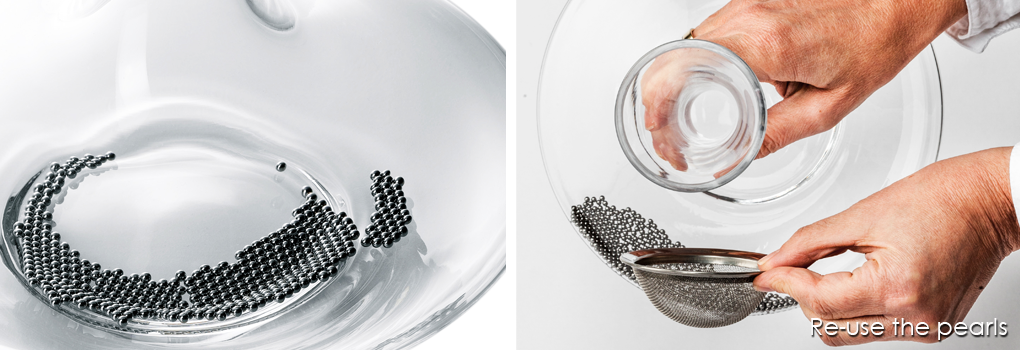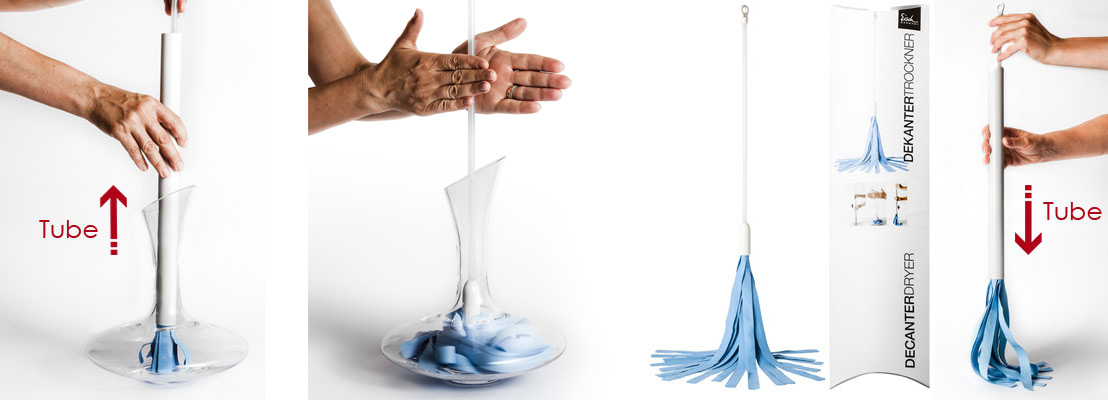When using your wine decanter frequently it can become stained as tannins and pigment from the red wine can build up a residue. Besides being unsightly, over time a thick wine residue or heavy water scale can slightly alter the aroma of future decanted wines. Regular cleaning keeps your decanter clean and stain-free, but if stains have built up, you can remove them to restore the condition of your wine decanter.
A Decanter Brush works very well (there are several options on the market). If you are getting a white film or scaling, it is likely from a calcium/hard water build-up. You can use a salt or vinegar and water solution, let it soak for a few hours, then wash it out several times with glass washing liquid and water, finally rinse thoroughly with warm water and dry upside down.
Decanter Cleaning:
To help understand how to remove the stains, keep in mind what the residue contains:
• Tannins - the older the wine, the less water-soluble the tannins can become.
• Pigments originally dissolved within the wine now oxidized, these dissolve well in alcohol.
• Residual and un-fermented sugars - various types; these dissolve easily in warm water.
• Acids - tartaric, malic, lactic, citric, etc.., all of which are moderately water soluble, and very soluble in alkaline solution, but are trapped within the residue.
• Plus an array of other organic molecules.
So the objective is to find something that dissolves these molecules in wine - or which chemically modifies them into something else that will dissolve and be removed easily.
1. White Wine:
Try to dissolve the residue in the decanter by using the same solvent in which the residue was originally dissolved, i.e. wine. Use a dry white wine that already has similar molecules which you are trying to dissolve within the residue. Alternatively, pour in a small volume of white spirit (e.g. vodka) with a splash of water. The higher alcohol can slowly dissolve some of the organic pigments in the residue, and the water will dissolve the acids and sugars. Though this process can take a long time (overnight) - wrap cling-film over the top of the decanter to stop the alcohol evaporating.
2. Dish-washing liquid and warm water:
This process can be slow (overnight) and with limited results if not done regularly. The first evidence of etching inside your decanter is a purplish colour on the surface of the glass. The purple colour comes, in part, from focused scattering of short wavelengths (purple/blue) by the small pits and scratches on the glass surface.
EISCH and other crystal decanters inevitably receive micro-scratches when dried with any cheap, ink printed, rough dish-towel. I recommend a no-scratch/no-residual smell method of drying a clean wine decanter. After washing with a top-quality soft glass-washing liquid, rinse well with tap water, and then rinse the inside twice with a small amount of jug-boiled water (let to cool), filtered or bottled water and let them air-dry upside down. No dry spots, no smells and no scratches.

3: For tough, heavy residue - you can use Decanter Cleaning Pearls:
When pouring the cleaning pearls, make sure to hold your decanter at an angle, so that you can easily pour them into the decanter gently and not just drop them straight in. Dropping metal-balls into a glass decanter could cause the glass to crack or worse break. Slowly pour them down the side of the decanter just as you would your favourite old wine.
Next, gently swirl the pearls around the bottom of the decanter in a circular motion. As you are swirling, the pearls are loosening, clearing away tannins and hard-to-reach residue left behind.
For a scrubbing agent that can be used with the cleaning pearls, you can use a table spoon or two of coarse rock-salt, which will remove residual wine without leaving any aroma, it will also soften your water, plus you can also use uncooked rice.
Another cleaning solution you can use: white vinegar and water (or alternatively, undiluted white vinegar), soft glass-washing liquid and water, denture tablets and water, baking soda and water, Soda water or lemon juice - regularly swirling these solutions around the decanter to help agitate the residue - these solutions can be left over night.
Key tips to slow down the need for the above residue removing techniques:
• Clean, rinse your decanter immediately after each use - so wine stains don't have time to build up or etch the glass.
• Soak a severely stained wine decanter in undiluted warm vinegar. Leave it to soak overnight to loosen the stains before washing it with soft glass-washing liquid.
• Be careful when cleaning a wine decanter. Leftover red wine in the bottom of the decanter can splash out and stain clothing. Rinse the decanter thoroughly with water before trying to remove the stains to prevent any accidental stains on your clothes.
• Do not use machine dish-washing tablets of powders when cleaning your wine decanter - as many have scouring agents that will only start or increase the etching process.

Drying the inside of a glass decanter can be a challenge. Those of you who use a wine decanter regularly will relate well with this issue and have struggled with achieving the desired result. After you have cleaned your decanter I am sure many of you have come up with or seen an array of unique ways and attempts to remove water droplets and moisture from the bottom, unreachable parts of a decanter out of reach of your fingers and a drying cloth.
After cleaning a decanter, when it comes to drying, you cannot simply just stand it upright and air dry. The water inside and on the bottom of the decanter condenses and becomes trapped, and if combined with any wine residue eventually can discolour the glass.

To help you dry a wine decanter regardless of its shape.
After cleaning, rinse the decanter with boiling water and then shake out as much water as possible and the heat will initiate and speed up the successful drying process. Drying a decanter after use is very important so as not to encourage water spots or worse, a film of calcium build-up from hard water.
The traditional option used by many wine enthusiasts at home and restaurants is to use a Decanter Drying Stand. As leaving the decanter standing-up-right to dry, the water droplets on the bottom of the decanter are impossible to remove. But turning a decanter upside down can be precarious (I have seen many staff try and balance decanters on top of warm espresso-coffee machines), but this becomes much easier if you use a decanter drying stand - *(the above stands are designed by Eisch). The drying stand allows all drops to dry spot-free, while balancing the decanter from falling over and breaking.
A drying stand is useful for getting a spot-free finish, the decanter drying stand can be nickel plated, stainless steel and with a silicone cap at the top of the stem to protect the decanter from slipping or scratches.
A relatively successful way to dry a decanter after use is to make a wick or twisted tight roll of thick paper-towel and feeding it into the decanter so it touches the bottom and leave for a good period of time, even overnight - if the decanter still has moisture, repeat the process with new dry paper-towel. Try not to lose the end of the paper towel, as it can be difficult to grab and remove if it falls to the bottom a large decanter with a very narrow neck.
Or a modern technique is the Eisch Decanter Dryer - Fabric Brush. You simply follow the 3 steps:
1. Place the fabric-brush which is in a tube into the neck of the decanter as shown. Then slide the tube up to expose the moisture absorbing fabric-fingers.
2. Twist the fabric-fingers / brush while inside the decanter as shown to effectively dry and polish the inside of the decanter.
3. Slide the tube back down the handle when removed - and then it is ready to use again.

Another option for home decanter users is for those lucky enough to have an airing cupboard - you can place them upside down on the stand in an airing cupboard overnight to remove any moisture. If you need to quickly dry water, moisture in a very short space of time - I have known friends to use a warm hair blow-dryer, used well away from water, to dry the inside of a decanter.
Whichever option / technique you use with your Decanter - be careful, as an Eisch Decanter is not only designed to be functional to aerate all wines - plus they come with the 'No-Drop' Affect, so the wine does not drip when pouring. But they are a piece or art - so you want it to be on show and in perfect condition.
For information on the Eisch 'SensisPlus' Stemware Range
